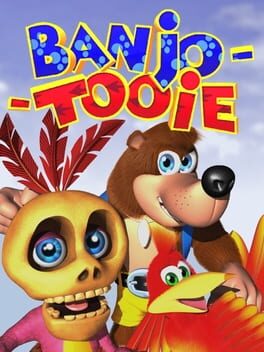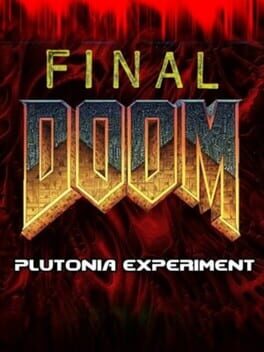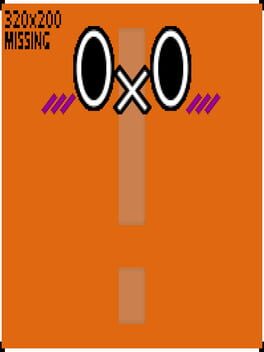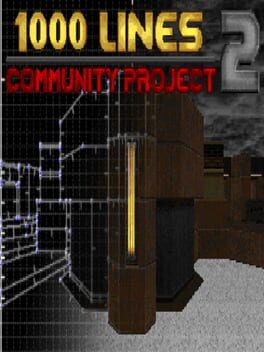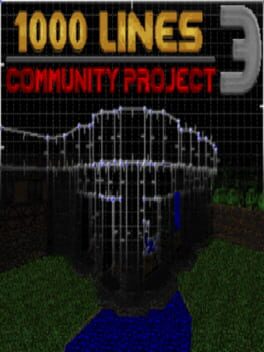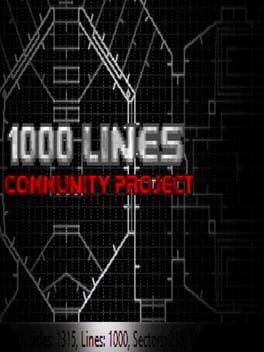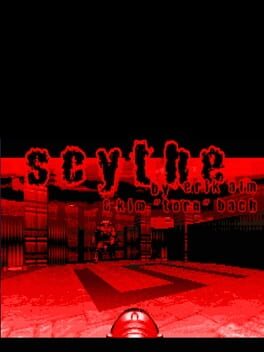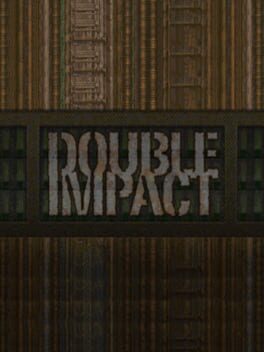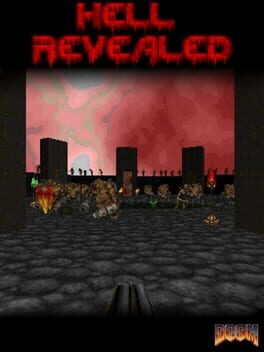lesbiandonkykong
5 reviews liked by lesbiandonkykong
Banjo-Tooie
2000
Flawed and ambitious, Banjo-Tooie is full of so many memorable ideas from the weird 'find the doubloons in this tiny town' of Jolly Roger's Lagoon, to combing a theme park for goodies. What stops these things from feeling merely like little fetch quests is that they usually relate to the moveset in some way - Banjo-Tooie is essentially a point-and-click-puzzle-mechanics adventure expressed through a fairly puzzle and exploration focused platformer. Sure the game is about 50/50 on whether these puzzles feel nice or not, but when things work it's a delight to see your moves put into some new joke or mini-story's context. I like that the moveset never becomes overly powerful: even if some moves amount to keys, the moves' scopes remain constrained enough to still give the levels personality by the end.
The level design goes all over the place, but the theming and little NPCs always pulls the levels together in at least an acceptable way (not all levels are great, of course.) Things feel thought out.
I have to give a hand to Grunty Industries for being so ambitious - we basically get a 3D Zelda dungeon, but far larger and ambitious than any Zelda dungeon ever made. Weaving between a building interior and exterior, spanning 5 floors, themed around all these aspects of a factory - on some ways it feels like a dungeon: it's so complex that it kind of eludes your full spatial comprehension of it, while still being 'logical' enough to somehow keep yourself oriented. Unlike the way some game dungeons give you maps so that you never miss a thing, Grunty Industries is happy to just let you not be able to find everything. "Don't 100% me, just leave the mystery until next time." I like that. The mystery isn't in some meta-layer or 4th-wall trick: the mystery is right in front of you, it's contained in your failure to grasp the ridiculous layout of the level. And in some ways that feels truer to life. When do we ever know the complete depth of anything?
...That being said, if you ever play this, make sure to bind fast-forward to your controller's R2 trigger. I mean you can play it the 'old normal' way if you want but I honestly don't think the added hours you'll spend walking slowly around will add much to the experience.
The level design goes all over the place, but the theming and little NPCs always pulls the levels together in at least an acceptable way (not all levels are great, of course.) Things feel thought out.
I have to give a hand to Grunty Industries for being so ambitious - we basically get a 3D Zelda dungeon, but far larger and ambitious than any Zelda dungeon ever made. Weaving between a building interior and exterior, spanning 5 floors, themed around all these aspects of a factory - on some ways it feels like a dungeon: it's so complex that it kind of eludes your full spatial comprehension of it, while still being 'logical' enough to somehow keep yourself oriented. Unlike the way some game dungeons give you maps so that you never miss a thing, Grunty Industries is happy to just let you not be able to find everything. "Don't 100% me, just leave the mystery until next time." I like that. The mystery isn't in some meta-layer or 4th-wall trick: the mystery is right in front of you, it's contained in your failure to grasp the ridiculous layout of the level. And in some ways that feels truer to life. When do we ever know the complete depth of anything?
...That being said, if you ever play this, make sure to bind fast-forward to your controller's R2 trigger. I mean you can play it the 'old normal' way if you want but I honestly don't think the added hours you'll spend walking slowly around will add much to the experience.
Metroid
1986
Pleasantly surprised at parts with Metroid! Dark Souls bonfire runs have nothing towards the run through Tourian, or making your way through ridiculously precise rooms of Kraid or Ridley's Lair before having to win at equally ridiculous fights.
The silence of Metroid's world works great - the art feels creepier and more organic as you go deeper into the planet, only to at times be replaced by the metallic architecture of Ridley or Kraid. It really conveys the sense of being in an alien planet, one that we'll never see all of, and one that wants Samus dead.
I found the moveset to be really well designed - not being able to shoot down and Samus being two tiles high means you have to really be aware of what's at your feet as well as how that distance affects where you shoot and jump. The screw attack adds an interesting (if chaotic) extra layer of strategy to later levels - although it feels powerful at first, it has an element of the unreliable against the flying beetles, and can feel slightly stiff to pull off in certain situations.
Enemy patterns can be very difficult but I feel like every room had some kind of 'solution', even if it was very hard to pull off. I found some of the timing windows too intense - the very long, narrow corridor in Ridley's lair with endless flying beetle pipes come to mind. Likewise, it can be hard to get your bearings as your health meter quickly depletes, with the game severely lagging when multiple enemies are on screen, and Samus's slightly limited movement conflicting with enemies that are somewhat too quick.
Health is hard to come by: this feels balanced throughout brinstar and Norfair, but takes a turn for the worse in Ridley and Kraid's areas. Part of this was that I never found the Varia suit (50% damage reduction!), but I do think that some of the long runs from the elevator to the bosses were just Too long, especially when you have to grind your health back after dying.
I thought the long beam, bombs, ice beam, missiles were all great additions to the arsenal, having their place within combat. Having the ice beam the whole game led to a really weird dynamic of having to be more precise with shots so as to not unfreeze enemies.
Room designs were generally pretty varied, and I liked that! It really felt like I was just stumbling across loot that the pirates left around - not as much like it was just a big world full of upgrades to find, designed just for me. That worked thematically with the setting. I liked that some rooms had an element of humor - the hidden hole near an energy tank, the secret morph ball passage beneath an otherwise very hard gauntlet, etc.
The copy pasted rooms felt a bit cheap, but it did add to the sense of being in a maze. I had a lot of fun drawing out my own maps for this game.
Overall I was pleasantly surprised! There's a lot to this game that could be improved, but I don't think improvement looks like Super Metroid. Key to this game are the arcade-y, yet nonlinear, stretches of making it to the next elevator or boss, and the way the game demands you to intimately know how to handle enemies and be on your guard. Things can go south really fast relative to other metroid games.
The silence of Metroid's world works great - the art feels creepier and more organic as you go deeper into the planet, only to at times be replaced by the metallic architecture of Ridley or Kraid. It really conveys the sense of being in an alien planet, one that we'll never see all of, and one that wants Samus dead.
I found the moveset to be really well designed - not being able to shoot down and Samus being two tiles high means you have to really be aware of what's at your feet as well as how that distance affects where you shoot and jump. The screw attack adds an interesting (if chaotic) extra layer of strategy to later levels - although it feels powerful at first, it has an element of the unreliable against the flying beetles, and can feel slightly stiff to pull off in certain situations.
Enemy patterns can be very difficult but I feel like every room had some kind of 'solution', even if it was very hard to pull off. I found some of the timing windows too intense - the very long, narrow corridor in Ridley's lair with endless flying beetle pipes come to mind. Likewise, it can be hard to get your bearings as your health meter quickly depletes, with the game severely lagging when multiple enemies are on screen, and Samus's slightly limited movement conflicting with enemies that are somewhat too quick.
Health is hard to come by: this feels balanced throughout brinstar and Norfair, but takes a turn for the worse in Ridley and Kraid's areas. Part of this was that I never found the Varia suit (50% damage reduction!), but I do think that some of the long runs from the elevator to the bosses were just Too long, especially when you have to grind your health back after dying.
I thought the long beam, bombs, ice beam, missiles were all great additions to the arsenal, having their place within combat. Having the ice beam the whole game led to a really weird dynamic of having to be more precise with shots so as to not unfreeze enemies.
Room designs were generally pretty varied, and I liked that! It really felt like I was just stumbling across loot that the pirates left around - not as much like it was just a big world full of upgrades to find, designed just for me. That worked thematically with the setting. I liked that some rooms had an element of humor - the hidden hole near an energy tank, the secret morph ball passage beneath an otherwise very hard gauntlet, etc.
The copy pasted rooms felt a bit cheap, but it did add to the sense of being in a maze. I had a lot of fun drawing out my own maps for this game.
Overall I was pleasantly surprised! There's a lot to this game that could be improved, but I don't think improvement looks like Super Metroid. Key to this game are the arcade-y, yet nonlinear, stretches of making it to the next elevator or boss, and the way the game demands you to intimately know how to handle enemies and be on your guard. Things can go south really fast relative to other metroid games.
It was nice to learn about Hiroji Kiyotake, one of the directors of Metroid II, and probably a leading force in the sheer personality and fun that a run of good GB platformers have - Metroid II, Super Mario Land 2, the Wario Lands...
Despite having played most Metroid games I'd never played Metroid 2. I bounced off of it a few times, but after roughing it through Metroid 1 (another brilliant game), I went ahead and played through 2.
At first I was hesitant about the structure of the game - seeming to move away from the chaotic maze of Metroid 1 for a more linear experience. But I think the structure of Metroid 2 - that of burrowing into an ant farm, exploring smaller labyrinths budding from a main path - works well. It enforces the narrative of Samus as this bounty hunter, cold bringer of death, her triumphant "overworld medley" song being replaced by the quiet nature and sounds of Metroids merely living at home.
The black and white graphics look amazing at times - especially level 3 with its mechanical sand maze and the vertical, overgrown shafts. At its best there's a real sense of encroaching into disturbing territory, the way it feels to peer from a safe path into a deep patch of forest. The variety of 'nests' the game manages to convey is inspiring! The game fully understands its visual format and how to exploit it. Metroid fights remain tricky to cheese, with the metroid becoming invincible offscreen, always feeling claustrophobic and chaotic, thrilling.
There are a handful of rough edges (the lack of save points, occasional missile/energy grinding) but I think the rest of the game makes up for it. I love the setpieces with the Metroid counter resetting in the lair, or the omega metroid attacking you after killing the alpha, or the lair of the omegas. I do think that the art could have been a bit more interesting at parts, especially with all of the vine background layers in level 3 - some later levels feel a bit empty .
That being said, the atmosphere never feels overexplained. It was fun to stumble upon the massive Chozo compounds, with dangerous robots, butted right up against Metroid caves and lush caverns.
Shoutout to the ambient music, which works really well! Unsettling, dark stuff, really understanding the 'texture' of the game boy sound palette.
--
Overall, it's a very strong game, but I can't give it the "5 stars'... I think it might be related to the economy of ammo and energy and how they inevitably shift way in your favor as you progress through the game - enemy encounters always feel a little less exciting once you have the screw attack, plasma beam, etc. It feels a bit counter to the narrative they're setting up with you diving into more dangerous lairs. The Omega metroid may look spooky, but it's not much of a threat with my 150 missiles, varia suit, and 500 energy.
Despite having played most Metroid games I'd never played Metroid 2. I bounced off of it a few times, but after roughing it through Metroid 1 (another brilliant game), I went ahead and played through 2.
At first I was hesitant about the structure of the game - seeming to move away from the chaotic maze of Metroid 1 for a more linear experience. But I think the structure of Metroid 2 - that of burrowing into an ant farm, exploring smaller labyrinths budding from a main path - works well. It enforces the narrative of Samus as this bounty hunter, cold bringer of death, her triumphant "overworld medley" song being replaced by the quiet nature and sounds of Metroids merely living at home.
The black and white graphics look amazing at times - especially level 3 with its mechanical sand maze and the vertical, overgrown shafts. At its best there's a real sense of encroaching into disturbing territory, the way it feels to peer from a safe path into a deep patch of forest. The variety of 'nests' the game manages to convey is inspiring! The game fully understands its visual format and how to exploit it. Metroid fights remain tricky to cheese, with the metroid becoming invincible offscreen, always feeling claustrophobic and chaotic, thrilling.
There are a handful of rough edges (the lack of save points, occasional missile/energy grinding) but I think the rest of the game makes up for it. I love the setpieces with the Metroid counter resetting in the lair, or the omega metroid attacking you after killing the alpha, or the lair of the omegas. I do think that the art could have been a bit more interesting at parts, especially with all of the vine background layers in level 3 - some later levels feel a bit empty .
That being said, the atmosphere never feels overexplained. It was fun to stumble upon the massive Chozo compounds, with dangerous robots, butted right up against Metroid caves and lush caverns.
Shoutout to the ambient music, which works really well! Unsettling, dark stuff, really understanding the 'texture' of the game boy sound palette.
--
Overall, it's a very strong game, but I can't give it the "5 stars'... I think it might be related to the economy of ammo and energy and how they inevitably shift way in your favor as you progress through the game - enemy encounters always feel a little less exciting once you have the screw attack, plasma beam, etc. It feels a bit counter to the narrative they're setting up with you diving into more dangerous lairs. The Omega metroid may look spooky, but it's not much of a threat with my 150 missiles, varia suit, and 500 energy.
Alien Vendetta
2001
My previous classic Doom review here.
Meditations on Doom
=== Mechanics ===
Bangai-O Spirits, Treasure's 2008 DS masterpiece, is superficially quite like Doom in structure. All the levels can be created and changed with the included editor, and players can (jankily) share levels online. However, a distinct trait of the game is that Treasure's mastery of mechanics-as-such is remarkably tolerant of sloppy level design. Many of the included levels are borderline shitposts, and fittingly, one of the best is just a pixel-art portrait of the player character with lots of enemies thrown in. Treasure has done most of the work for you: all you need to do is place some stuff in the editor and let it rip.
In contrast, Doom levels need to be constructed with intentionality - certainly the enemies' AI pull some weight on their own but smart placement vastly amplifies their effectiveness. Huy Pham, creator of Deus Vult II, cites Alien Vendetta as a major inspiration and draws explicit comparisons to chess in the included text file:
"Map20 of DVII is a strong example of the Chess influence with the natural, non-teleport monster traps that simply springs from the map's sneaky layout. The Berserk trap on the uppermost level of Map20 is a reflection of a forced combination, with low health, the player is compelled to pick up the stimpack, entering the trap full of imps, grabbing the berserk as a counterattack, and then confronting the counter-counterattacking hell knight. In the yellow key complex, the two barons of hell were placed like two rooks on open files, firing down the corridor and putting pressure on the player's position and inducing him to make a mistake. The final archvile after taking the blue armor was placed in a way that parallels the black fianchettoed bishop in the Sicilian Dragon Yugoslav Attack opening, firing down the most crucial control point in the room."
The concept here is territory control. Chess is an apt comparison, but what's really interesting is to notice the similarities to shmups, that other game genre so focused on real-time territory control. The heavy emphasis on projectiles in Doom's combat means many common shmup techniques/concepts, such as streaming, moving with projectiles, misdirecting, safe spots, dodging within vs. outside of patterns, holding ground closer to enemies to keep control of space behind you, etc. directly translate.
In a structural sense, a tough section in a shmup demands a unity of macro-level routing, micro-level decisionmaking, and instinctual execution. Take Dodonpachi Daioujou's "hive" from stage 5. Clearing this demands the player work out a viable path that kills key enemies quickly while leaving movement paths open, have the requisite ability to precisely control their ship, and be able to quickly adapt to the slight unpredictability of bullet trajectories. Alien Vendetta's Map 32: No Guts No Glory (while being far less intense) uses those same core elements of macro-level routing through the map, micro-level decisionmaking via unpredictability of monster AI, and instinctual execution.
Like most shmups, and many older arcade-style games in general, there's also an intense focus on the fundamentals of movement and positioning. In this dev diary, Matthewmatosis talks about how compared to classic 2D games like Ghosts 'n Goblins, defensive decisionmaking in many 3D action games has been simplified by powerful get-out-of-jail-free cards such as rolls and parries:
"Imagine you were tasked with creating an AI which could complete these games without taking damage. You have access to all the relevant variables like enemy position and status, in other words you know when an attack is one frame away from hitting the player character. Despite being one of the most recent releases on the list, Devil May Cry 5 is one of the easiest to solve, especially if we’re talking about Bloody Palace. Simply attack until you’re in danger, then instantly activate Royalguard to negate damage. Others like Revengeance and Sekiro will require slightly more awareness about which attack type is coming but will ultimately be solved by pressing a certain button in response to the enemy...this isn’t some irrelevant curiosity, these defensive algorithms are running in your brain as you play...think about how clever Arthur’s [GnG player character] AI would need to be by comparison. If a grim reaper is running at him, it’s not enough to jump or throw a dagger on the last possible frame. You need to be able to think ahead and position yourself in the safest way to advance."
Doom is decidedly part of this old-school tradition, where avoiding sticky situations is contingent on many higher-level decisions that can't be easily reversed on a whim. High-level player David Assad has a great video on how survival in many tough fights demands creating space, which demands tactical play. Youtuber SoBad explains how the conventional advice about monster prioritization is in practice highly dependent on enemy positioning and composition (and he doesn't even mention infighting!). And in a nonlinear map, routing can recontextualize all of this.
My favorite map in Alien Vendetta is probably Anders Johnsen's Dark Dome. What's really cool about this map is how nearly the entire level is open to you from the start. This is because the entire level is shooting at you from the start. The opening minutes are a frenzied scramble to carve out a foothold somewhere as you dart around while constantly under fire. Clearing out one area opens up angles to attack new ones, which do the same in turn; this style of mapping has been called "zone-of-influence". And one of the great things that flows from this structure is how many viable ways there are to route the map. I used an invincibility to clear out a Archvile-guarded Revenant bonepile, but you might opt to assault from the window overlook instead and save it for one of the close-range Cyberdemon tangoes.
The "hot starts" in maps like Dark Dome also illuminates a truth: running away is deep! Trying to squeeze past a mob of chittering Revenants can be just as engaging as filling them with buckshot, and meaningfully deciding between the two is a joy rarely afforded in modern games. And those living Revenants won't just disappear: maybe later they'll pop back up at an inopportune time, or join the fray of another brawl. Mancubus battalions meet Cacodemon migrations; Cyberdemons rage at far-flung Revenant missiles; caged Archviles catch quick glimpses of their foe across twisted geometry; the boundaries between encounters, so rigid in most games, loosen, and their contents ooze together.
Certainly the door problem is a foremost cause of this rigidity, and some lock-ins here and there (like the BFG survival-horror blue key room) are far from unwelcome, but we can give up a bit of ground. Let the player play lame if they really want, you're not their babysitter. It's worth it when what's gained is a unique structure and flow that I haven't seen in any other game.
Even in 2022, especially in 2022, Doom has a wealth of ideas to offer. Don't think the iceberg stops at surface-level elements like fast movespeed or no reloading. Dig deeper and you'll find something timeless yet shockingly ahead of its time, a medium for mappers to explore yet grounded by solid and versatile fundamentals. Universally known, widely loved, rarely appreciated, never replicated.
=== History ===
"By the turn of the millennium, many players and mappers had moved on from Doom to Quake and other more modern games. Some of the greatest early mappers, including Iikka Keranen, Matthias Worch, and Dario Casali, had graduated to careers in commercial game design. Many of the major post-Requiem mappers—Anders Johnsen, Anthony Soto, Brad Spencer, Lee Szymanski, Kim Andre Malde, and others—had gotten together to create a team megawad out of Johnsen’s struggling one-man project, after which most of them would drift away from Doom. The twilight of the game’s odd little mapping community had always seemed like it would inevitably arrive sooner or later, and with the coming of the new millennium and the biggest of the “Doom killer” games themselves becoming obsolete, it must have felt more imminent than ever.
In other words, it was about time for somebody to create the most influential PWAD of all time."
- The Roots of Doom Mapping on Alien Vendetta
As you can probably tell if you've read any of my other writings, I'm mostly a "mechanics person". That's not to disparage other aspects of games, it's merely what I enjoy analyzing. But even for someone like myself, when playing Alien Vendetta it's impossible not to get sucked into the sheer history of it all.
Playing Misri Halek, listed as the most memorable map in history by Doomworld, might not have been a particularly great experience for me in an immediate gameplay sense. But imagine someone in 2001 experiencing something with this scale and architecture in a virtual world for the first time: how breathtaking and inspiring it must have been! (Luckily most of the maps have good gameplay too.)
Authorship is a large part of this meta-appreciation. After you beat a level, the stats screen lists the map creator(s) right under the title. Just spent hours banging your head against Dark Dome? You have Anders Johnsen to thank for that. And in a collaborative project, much like the original Doom games, each author has a distinct style. See Brad Spencer's name? Expect a fangs-bared techbase. Kim Andre Malde? Thick atmosphere and striking architecture. Anders Johnsen? Anything from a brisk romp to an all-out siege assault, depending on what the larger progression demands.
This is a pleasure that sadly seems to be limited to small indie teams and modding scenes. Devil May Cry 3's first level is one of the most fun to play in the series, but I have no clue who to credit for it. Itsuno the game director? One of the 10+ programmers listed in the credits? Someone else? Sometimes names emerge from the mist, but it's rare. In this sense, Doom is far more akin to a music genre or art scene: webs of influence can be traced, styles explored.
The larger narrative is equally captivating. It might be easy to forget, but Doom has really been "indie" from the beginning. id Software was just a handful of guys working out of a random building, and the community has always been just a bunch of fans making stuff as a hobby for the game they love. Certainly Doom was massively popular and influential, but there was no guarantee that the scene behind it would last.
Alien Vendetta is a line in the sand. A vindication of the past: 7 years on and the Doom 2 fundamentals aren't even close to being exhausted. A gift to the present: here's our last hurrah. A signpost to the future: mappers, look at what we did, what you can do. Surely you can do better, hmmm?
Playing with the custom MIDI pack feels fitting. Alien Vendetta was a gift to the community; now the community gives back. It's hard not to sense the emotion in Anders Johnsen's reaction to this WAD, 20 years later, still getting love from Doom players new and old.
For that matter, it's hard to imagine anyone at the time foreseeing what the classic Doom scene has become. Alien Vendetta's synthesis of aesthetics and challenge has been driven into new territory, most uniquely with Sunder and its slaughter progeny. Thanks to Doom's engine code being released, sourceports provide a modern experience while preserving all the idiosyncracies of the original, if you so desire. While level design has seemingly stagnated or even regressed in gaming at large, what's on offer in custom Doom maps, through three decades of knowledge, has risen to the best in the medium bar none.
So often, it feels like this medium has a capricious taste and a forgetful memory. Like so many others, Doom should have been confined to the history books, an unmoving artifact, a museum piece that gets gestured to when people talk about the FPS genre, then locked back up in its case. Maybe a few would see the deeper possibilities, feel intrigue and sadness, then get dragged along with the tide like all the others. Everyone moves on.
Not this time.
The fire still burns!
Meditations on Doom
=== Mechanics ===
Bangai-O Spirits, Treasure's 2008 DS masterpiece, is superficially quite like Doom in structure. All the levels can be created and changed with the included editor, and players can (jankily) share levels online. However, a distinct trait of the game is that Treasure's mastery of mechanics-as-such is remarkably tolerant of sloppy level design. Many of the included levels are borderline shitposts, and fittingly, one of the best is just a pixel-art portrait of the player character with lots of enemies thrown in. Treasure has done most of the work for you: all you need to do is place some stuff in the editor and let it rip.
In contrast, Doom levels need to be constructed with intentionality - certainly the enemies' AI pull some weight on their own but smart placement vastly amplifies their effectiveness. Huy Pham, creator of Deus Vult II, cites Alien Vendetta as a major inspiration and draws explicit comparisons to chess in the included text file:
"Map20 of DVII is a strong example of the Chess influence with the natural, non-teleport monster traps that simply springs from the map's sneaky layout. The Berserk trap on the uppermost level of Map20 is a reflection of a forced combination, with low health, the player is compelled to pick up the stimpack, entering the trap full of imps, grabbing the berserk as a counterattack, and then confronting the counter-counterattacking hell knight. In the yellow key complex, the two barons of hell were placed like two rooks on open files, firing down the corridor and putting pressure on the player's position and inducing him to make a mistake. The final archvile after taking the blue armor was placed in a way that parallels the black fianchettoed bishop in the Sicilian Dragon Yugoslav Attack opening, firing down the most crucial control point in the room."
The concept here is territory control. Chess is an apt comparison, but what's really interesting is to notice the similarities to shmups, that other game genre so focused on real-time territory control. The heavy emphasis on projectiles in Doom's combat means many common shmup techniques/concepts, such as streaming, moving with projectiles, misdirecting, safe spots, dodging within vs. outside of patterns, holding ground closer to enemies to keep control of space behind you, etc. directly translate.
In a structural sense, a tough section in a shmup demands a unity of macro-level routing, micro-level decisionmaking, and instinctual execution. Take Dodonpachi Daioujou's "hive" from stage 5. Clearing this demands the player work out a viable path that kills key enemies quickly while leaving movement paths open, have the requisite ability to precisely control their ship, and be able to quickly adapt to the slight unpredictability of bullet trajectories. Alien Vendetta's Map 32: No Guts No Glory (while being far less intense) uses those same core elements of macro-level routing through the map, micro-level decisionmaking via unpredictability of monster AI, and instinctual execution.
Like most shmups, and many older arcade-style games in general, there's also an intense focus on the fundamentals of movement and positioning. In this dev diary, Matthewmatosis talks about how compared to classic 2D games like Ghosts 'n Goblins, defensive decisionmaking in many 3D action games has been simplified by powerful get-out-of-jail-free cards such as rolls and parries:
"Imagine you were tasked with creating an AI which could complete these games without taking damage. You have access to all the relevant variables like enemy position and status, in other words you know when an attack is one frame away from hitting the player character. Despite being one of the most recent releases on the list, Devil May Cry 5 is one of the easiest to solve, especially if we’re talking about Bloody Palace. Simply attack until you’re in danger, then instantly activate Royalguard to negate damage. Others like Revengeance and Sekiro will require slightly more awareness about which attack type is coming but will ultimately be solved by pressing a certain button in response to the enemy...this isn’t some irrelevant curiosity, these defensive algorithms are running in your brain as you play...think about how clever Arthur’s [GnG player character] AI would need to be by comparison. If a grim reaper is running at him, it’s not enough to jump or throw a dagger on the last possible frame. You need to be able to think ahead and position yourself in the safest way to advance."
Doom is decidedly part of this old-school tradition, where avoiding sticky situations is contingent on many higher-level decisions that can't be easily reversed on a whim. High-level player David Assad has a great video on how survival in many tough fights demands creating space, which demands tactical play. Youtuber SoBad explains how the conventional advice about monster prioritization is in practice highly dependent on enemy positioning and composition (and he doesn't even mention infighting!). And in a nonlinear map, routing can recontextualize all of this.
My favorite map in Alien Vendetta is probably Anders Johnsen's Dark Dome. What's really cool about this map is how nearly the entire level is open to you from the start. This is because the entire level is shooting at you from the start. The opening minutes are a frenzied scramble to carve out a foothold somewhere as you dart around while constantly under fire. Clearing out one area opens up angles to attack new ones, which do the same in turn; this style of mapping has been called "zone-of-influence". And one of the great things that flows from this structure is how many viable ways there are to route the map. I used an invincibility to clear out a Archvile-guarded Revenant bonepile, but you might opt to assault from the window overlook instead and save it for one of the close-range Cyberdemon tangoes.
The "hot starts" in maps like Dark Dome also illuminates a truth: running away is deep! Trying to squeeze past a mob of chittering Revenants can be just as engaging as filling them with buckshot, and meaningfully deciding between the two is a joy rarely afforded in modern games. And those living Revenants won't just disappear: maybe later they'll pop back up at an inopportune time, or join the fray of another brawl. Mancubus battalions meet Cacodemon migrations; Cyberdemons rage at far-flung Revenant missiles; caged Archviles catch quick glimpses of their foe across twisted geometry; the boundaries between encounters, so rigid in most games, loosen, and their contents ooze together.
Certainly the door problem is a foremost cause of this rigidity, and some lock-ins here and there (like the BFG survival-horror blue key room) are far from unwelcome, but we can give up a bit of ground. Let the player play lame if they really want, you're not their babysitter. It's worth it when what's gained is a unique structure and flow that I haven't seen in any other game.
Even in 2022, especially in 2022, Doom has a wealth of ideas to offer. Don't think the iceberg stops at surface-level elements like fast movespeed or no reloading. Dig deeper and you'll find something timeless yet shockingly ahead of its time, a medium for mappers to explore yet grounded by solid and versatile fundamentals. Universally known, widely loved, rarely appreciated, never replicated.
=== History ===
"By the turn of the millennium, many players and mappers had moved on from Doom to Quake and other more modern games. Some of the greatest early mappers, including Iikka Keranen, Matthias Worch, and Dario Casali, had graduated to careers in commercial game design. Many of the major post-Requiem mappers—Anders Johnsen, Anthony Soto, Brad Spencer, Lee Szymanski, Kim Andre Malde, and others—had gotten together to create a team megawad out of Johnsen’s struggling one-man project, after which most of them would drift away from Doom. The twilight of the game’s odd little mapping community had always seemed like it would inevitably arrive sooner or later, and with the coming of the new millennium and the biggest of the “Doom killer” games themselves becoming obsolete, it must have felt more imminent than ever.
In other words, it was about time for somebody to create the most influential PWAD of all time."
- The Roots of Doom Mapping on Alien Vendetta
As you can probably tell if you've read any of my other writings, I'm mostly a "mechanics person". That's not to disparage other aspects of games, it's merely what I enjoy analyzing. But even for someone like myself, when playing Alien Vendetta it's impossible not to get sucked into the sheer history of it all.
Playing Misri Halek, listed as the most memorable map in history by Doomworld, might not have been a particularly great experience for me in an immediate gameplay sense. But imagine someone in 2001 experiencing something with this scale and architecture in a virtual world for the first time: how breathtaking and inspiring it must have been! (Luckily most of the maps have good gameplay too.)
Authorship is a large part of this meta-appreciation. After you beat a level, the stats screen lists the map creator(s) right under the title. Just spent hours banging your head against Dark Dome? You have Anders Johnsen to thank for that. And in a collaborative project, much like the original Doom games, each author has a distinct style. See Brad Spencer's name? Expect a fangs-bared techbase. Kim Andre Malde? Thick atmosphere and striking architecture. Anders Johnsen? Anything from a brisk romp to an all-out siege assault, depending on what the larger progression demands.
This is a pleasure that sadly seems to be limited to small indie teams and modding scenes. Devil May Cry 3's first level is one of the most fun to play in the series, but I have no clue who to credit for it. Itsuno the game director? One of the 10+ programmers listed in the credits? Someone else? Sometimes names emerge from the mist, but it's rare. In this sense, Doom is far more akin to a music genre or art scene: webs of influence can be traced, styles explored.
The larger narrative is equally captivating. It might be easy to forget, but Doom has really been "indie" from the beginning. id Software was just a handful of guys working out of a random building, and the community has always been just a bunch of fans making stuff as a hobby for the game they love. Certainly Doom was massively popular and influential, but there was no guarantee that the scene behind it would last.
Alien Vendetta is a line in the sand. A vindication of the past: 7 years on and the Doom 2 fundamentals aren't even close to being exhausted. A gift to the present: here's our last hurrah. A signpost to the future: mappers, look at what we did, what you can do. Surely you can do better, hmmm?
Playing with the custom MIDI pack feels fitting. Alien Vendetta was a gift to the community; now the community gives back. It's hard not to sense the emotion in Anders Johnsen's reaction to this WAD, 20 years later, still getting love from Doom players new and old.
For that matter, it's hard to imagine anyone at the time foreseeing what the classic Doom scene has become. Alien Vendetta's synthesis of aesthetics and challenge has been driven into new territory, most uniquely with Sunder and its slaughter progeny. Thanks to Doom's engine code being released, sourceports provide a modern experience while preserving all the idiosyncracies of the original, if you so desire. While level design has seemingly stagnated or even regressed in gaming at large, what's on offer in custom Doom maps, through three decades of knowledge, has risen to the best in the medium bar none.
So often, it feels like this medium has a capricious taste and a forgetful memory. Like so many others, Doom should have been confined to the history books, an unmoving artifact, a museum piece that gets gestured to when people talk about the FPS genre, then locked back up in its case. Maybe a few would see the deeper possibilities, feel intrigue and sadness, then get dragged along with the tide like all the others. Everyone moves on.
Not this time.
The fire still burns!
Love Is... conceiving your son Milo Casali by artificial insemination, to the chagrin of the Vatican, and announcing this proudly in your comic strip. Love Is... the Casali sons making their own staple of pop media in a similarly simple but unexpected way.
Love Is... the Plutonia Experiment, if I might be so bold. There's nothing but love throughout this entire mapset, a perennial standout among the classic Doom games for reasons debated to this day. For 1996, the mapping designs and concepts employed in PLUTONIA.WAD were avant-garde, yet seem very obvious and simple to modern Doom players. The Casali brothers were done playing by the rules and conventions fellow fan creators were bound to, from overt attempts at realism ("DoomCute" in today's parlage) to prizing adventuring and cheap thrills over exacting endurance tests of skill. For Dario & Milo, it was now or never to challenge, even brutalize their community. A kind of tough love, perhaps.
As a fanmade map pack turned second half of Final Doom, Plutonia serves as a necessary foil to TNT: Evilution's excesses and concessions. The Casalis bros. knew their community maps well, and had already been pushing the possibilities of the pre-source port Doom engine with solo releases like PUNISHER.WAD and BUTCHER.WAD. After id software witnessed their contributions to TNT.WAD—two of the most polished maps in that whole set, Dario's "Pharaoh" and Milo's "Heck"—they met and discussed making a whole new expansion pack to feature in Final Doom. The early maps they showed American McGee quickly became the start for Plutonia, which Dario & Milo had much less time to work on than TeamTNT had for their own mapset.
I could go further into The Plutonia Experiment's history, but Doomworld and Dario's own contributions paint more of the picture already. What you should know on a first playthrough is that one cannot just like this WAD. Nearly everyone I know in the Doom fandom either loves or hates this monument to mid-'90s FPS experimentation. It's more than reasonable to run through Plutonia on a lower difficulty since the maps are well-designed to retain their intensity and skill demands on Hurt Me Plenty at least. But the Casalis built this game as the kind of Japanese game show obstacle course any Doom player in '96 would approach with caution, if not trepidation. There's no remorse, little reprieve, and relatively few dull moments anywhere throughout Plutonia's alienating, jungle-laden mess of arenas, gauntlets, and set-pieces. Tough love indeed.
Not every level hits these marks. I can list some of my own pet-hate experiences, from the very poorly telegraphed "Indiana Jones" invisible bridge in MAP02: Well of Souls, to the cramped teleporting Archvile trap wrecking first-time players in MAP12: Speed. A couple of maps utterly put me off even now, mainly MAP20: The Death Domain (too many gotchas, not enough chances to take cover) or MAP30: Gateway to Hell (another needless tradition, the Icon of Sin finale). Otherwise, that leaves us with thirty difficult but rewarding maps combining Doom II's masterful combat design with more streamlined, less noodly levels to navigate. I think it's a winning combination, even if some 1996 contemporaries like the Memento Mori II mapset showcase prettier or more conceptually ambitious works.
One thing that absolutely works in Plutonia's favor is its difficult but fair approach to most combat scenarios. This is not anything like a Mario kaizo hack or masocore gaming in general. But you'll have every reason to approach fights strategically, using the right weapons and movement at the right time to survive. Both of the brothers prefer small but uniquely lethal combinations of monsters to the giant hordes you see in many popular maps today. Economy of design defines this set in contrast to not just Evilution, but other community-made packs from the time like Memento Mori. A single archvile, a couple revenants, and some cannon fodder imps...put them in a non-trivial space to travel around and you'll have one hell of a battle!
To this end, most maps shower you in higher-tier ammo for those upper-level weapons. Expect to learn the ins and outs of rocket launcher splash damage, or how to efficiently wield the BFG's invisible tracer spread fire. Practice hard enough and you'll get a feel for how to conserve super shotgun ammo as you mow down pinkies, or the basics of redirecting skeleton fireballs into other foes to get them infighting. The Casalis weren't making hard-ass shit for the sake of being hardasses. At a time when speedrunning demos were gaining popularity and the Doom community's skills and metagame were evolving, these two just wanted to gift everyone a bloody chocolate box for Valentine's. True love waits.
Funny thing is, these maps aren't as bizarre or off-putting as one might think, at least when you realize they're clever remixes of id's own levels! It makes sense how, with only several weeks to build and test their vanilla-compatible maps largely by themselves, the Casalis would chop up useful bits from Doom I & II for their own purposes. Milo's MAP21: Slayer is an obvious riff on 'O' of Destruction and other Romero levels, for instance, while Dario's works like MAP08: Realm liberally borrow ideas from Sandy Petersen's oft-maligned creations. This does mean the set can't be as revelatory or unique as it could have, despite some memorable new ideas like the iconic archvile maze in MAP11. Still, there's plenty of clever trope reuse all throughout Plutonia that had few if any contenders in the community back then. We're a decade-and-a-half off from projects like Doom the Way id Did, after all, and these time-saving homages to the original games came in clutch for the project.
Some make this more obvious than others, like the utterly chaotic, classic slaughtermap remix of MAP01: Entryway from Doom II. This new creation, Go 2 It, even seems at odds with the spare monster placement and emphasis on precision attrition Plutonia's advocated for up until now. Hundreds of baddies swarm the bones of an opening stage best known then as the main multiplayer 1v1 map. Yet applying your newfound reflexes and reactions to enemy attacks makes the original slaughter experience not just viable, but fucking brilliant to play. All these funny lil' guys on screen are just going to kill each other anyway if you can juke them into hitting one another. Simple strategies lead to satisfying successes. It's more than just "git gud", as some will profess—more so getting flexible and adapting to scary but beatable challenges as you go.
Without Plutonia, I'm not sure I'd have ever gotten into Doom mapping, let alone a ton of newer fan creations both easier and harder than Final Doom. This feels like a necessary leap in complexity and player demands, one that's often a bit too harsh and formulaic yet well-meaning with how it challenges you. If Doom II proved that id's template was no fluke, and community efforts like Evilution and Memento Mori II showcased the story-/adventure-driven possibilities of new maps, then Plutonia's a necessary course correction for its time. The Casalis loved not just how they could push the engine to its theorized limits, but how they could maximize Romero & Petersen's game design for all its worth. What others see as unfair (which I occasionally agree with), I see as ascetic and utterly focused on avoiding downtime. There's just enough negative space in these maps between encounters to give you a breather, but never too much to bore.
Love Is... a compelling mixture, a chemical reaction that keeps you invested. It might get ugly and wear you down at times, yet it keeps you coming back. Sure it can be painful, as much as life ought not to. But if it helps you grow stronger, more understanding and empathetic, is that such a bad trade? I've had a healthy relationship with The Plutonia Experiment for years now, one which taught me make simple but effective moves in combat, or fun maps for my friends to play. This kind of appreciation takes time and effort; I won't fault anyone if they can't commit to it, and I recognize the privileges one might need to get this far. In the end, I like to think it's all been worth the patience. True love waits.
Love Is... the Plutonia Experiment, if I might be so bold. There's nothing but love throughout this entire mapset, a perennial standout among the classic Doom games for reasons debated to this day. For 1996, the mapping designs and concepts employed in PLUTONIA.WAD were avant-garde, yet seem very obvious and simple to modern Doom players. The Casali brothers were done playing by the rules and conventions fellow fan creators were bound to, from overt attempts at realism ("DoomCute" in today's parlage) to prizing adventuring and cheap thrills over exacting endurance tests of skill. For Dario & Milo, it was now or never to challenge, even brutalize their community. A kind of tough love, perhaps.
As a fanmade map pack turned second half of Final Doom, Plutonia serves as a necessary foil to TNT: Evilution's excesses and concessions. The Casalis bros. knew their community maps well, and had already been pushing the possibilities of the pre-source port Doom engine with solo releases like PUNISHER.WAD and BUTCHER.WAD. After id software witnessed their contributions to TNT.WAD—two of the most polished maps in that whole set, Dario's "Pharaoh" and Milo's "Heck"—they met and discussed making a whole new expansion pack to feature in Final Doom. The early maps they showed American McGee quickly became the start for Plutonia, which Dario & Milo had much less time to work on than TeamTNT had for their own mapset.
I could go further into The Plutonia Experiment's history, but Doomworld and Dario's own contributions paint more of the picture already. What you should know on a first playthrough is that one cannot just like this WAD. Nearly everyone I know in the Doom fandom either loves or hates this monument to mid-'90s FPS experimentation. It's more than reasonable to run through Plutonia on a lower difficulty since the maps are well-designed to retain their intensity and skill demands on Hurt Me Plenty at least. But the Casalis built this game as the kind of Japanese game show obstacle course any Doom player in '96 would approach with caution, if not trepidation. There's no remorse, little reprieve, and relatively few dull moments anywhere throughout Plutonia's alienating, jungle-laden mess of arenas, gauntlets, and set-pieces. Tough love indeed.
Not every level hits these marks. I can list some of my own pet-hate experiences, from the very poorly telegraphed "Indiana Jones" invisible bridge in MAP02: Well of Souls, to the cramped teleporting Archvile trap wrecking first-time players in MAP12: Speed. A couple of maps utterly put me off even now, mainly MAP20: The Death Domain (too many gotchas, not enough chances to take cover) or MAP30: Gateway to Hell (another needless tradition, the Icon of Sin finale). Otherwise, that leaves us with thirty difficult but rewarding maps combining Doom II's masterful combat design with more streamlined, less noodly levels to navigate. I think it's a winning combination, even if some 1996 contemporaries like the Memento Mori II mapset showcase prettier or more conceptually ambitious works.
One thing that absolutely works in Plutonia's favor is its difficult but fair approach to most combat scenarios. This is not anything like a Mario kaizo hack or masocore gaming in general. But you'll have every reason to approach fights strategically, using the right weapons and movement at the right time to survive. Both of the brothers prefer small but uniquely lethal combinations of monsters to the giant hordes you see in many popular maps today. Economy of design defines this set in contrast to not just Evilution, but other community-made packs from the time like Memento Mori. A single archvile, a couple revenants, and some cannon fodder imps...put them in a non-trivial space to travel around and you'll have one hell of a battle!
To this end, most maps shower you in higher-tier ammo for those upper-level weapons. Expect to learn the ins and outs of rocket launcher splash damage, or how to efficiently wield the BFG's invisible tracer spread fire. Practice hard enough and you'll get a feel for how to conserve super shotgun ammo as you mow down pinkies, or the basics of redirecting skeleton fireballs into other foes to get them infighting. The Casalis weren't making hard-ass shit for the sake of being hardasses. At a time when speedrunning demos were gaining popularity and the Doom community's skills and metagame were evolving, these two just wanted to gift everyone a bloody chocolate box for Valentine's. True love waits.
Funny thing is, these maps aren't as bizarre or off-putting as one might think, at least when you realize they're clever remixes of id's own levels! It makes sense how, with only several weeks to build and test their vanilla-compatible maps largely by themselves, the Casalis would chop up useful bits from Doom I & II for their own purposes. Milo's MAP21: Slayer is an obvious riff on 'O' of Destruction and other Romero levels, for instance, while Dario's works like MAP08: Realm liberally borrow ideas from Sandy Petersen's oft-maligned creations. This does mean the set can't be as revelatory or unique as it could have, despite some memorable new ideas like the iconic archvile maze in MAP11. Still, there's plenty of clever trope reuse all throughout Plutonia that had few if any contenders in the community back then. We're a decade-and-a-half off from projects like Doom the Way id Did, after all, and these time-saving homages to the original games came in clutch for the project.
Some make this more obvious than others, like the utterly chaotic, classic slaughtermap remix of MAP01: Entryway from Doom II. This new creation, Go 2 It, even seems at odds with the spare monster placement and emphasis on precision attrition Plutonia's advocated for up until now. Hundreds of baddies swarm the bones of an opening stage best known then as the main multiplayer 1v1 map. Yet applying your newfound reflexes and reactions to enemy attacks makes the original slaughter experience not just viable, but fucking brilliant to play. All these funny lil' guys on screen are just going to kill each other anyway if you can juke them into hitting one another. Simple strategies lead to satisfying successes. It's more than just "git gud", as some will profess—more so getting flexible and adapting to scary but beatable challenges as you go.
Without Plutonia, I'm not sure I'd have ever gotten into Doom mapping, let alone a ton of newer fan creations both easier and harder than Final Doom. This feels like a necessary leap in complexity and player demands, one that's often a bit too harsh and formulaic yet well-meaning with how it challenges you. If Doom II proved that id's template was no fluke, and community efforts like Evilution and Memento Mori II showcased the story-/adventure-driven possibilities of new maps, then Plutonia's a necessary course correction for its time. The Casalis loved not just how they could push the engine to its theorized limits, but how they could maximize Romero & Petersen's game design for all its worth. What others see as unfair (which I occasionally agree with), I see as ascetic and utterly focused on avoiding downtime. There's just enough negative space in these maps between encounters to give you a breather, but never too much to bore.
Love Is... a compelling mixture, a chemical reaction that keeps you invested. It might get ugly and wear you down at times, yet it keeps you coming back. Sure it can be painful, as much as life ought not to. But if it helps you grow stronger, more understanding and empathetic, is that such a bad trade? I've had a healthy relationship with The Plutonia Experiment for years now, one which taught me make simple but effective moves in combat, or fun maps for my friends to play. This kind of appreciation takes time and effort; I won't fault anyone if they can't commit to it, and I recognize the privileges one might need to get this far. In the end, I like to think it's all been worth the patience. True love waits.
